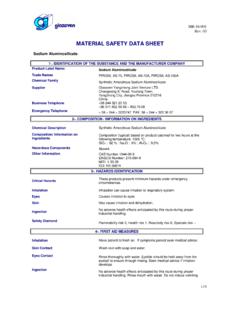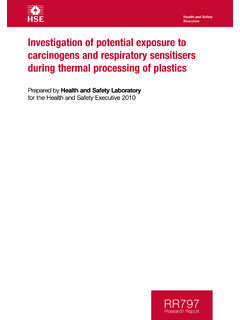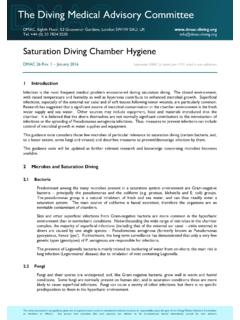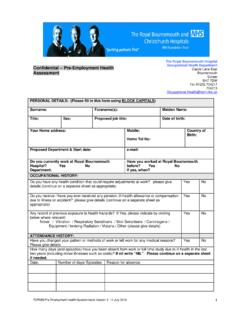Transcription of OPINION on Fragrance allergens in cosmetic …
1 SCCS/1459/11. Scientific Committee on Consumer Safety SCCS. OPINION . on Fragrance allergens in cosmetic products The SCCS adopted this OPINION at its 15th plenary meeting of 26-27 June 2012. SCCS/1459/11. OPINION on Fragrance allergens in cosmetic products _____. About the Scientific Committees Three independent non-food Scientific Committees provide the Commission with the scientific advice it needs when preparing policy and proposals relating to consumer safety, public health and the environment. The Committees also draw the Commission's attention to the new or emerging problems which may pose an actual or potential threat.
2 They are: the Scientific Committee on Consumer Safety (SCCS), the Scientific Committee on Health and Environmental Risks (SCHER) and the Scientific Committee on Emerging and Newly Identified Health Risks (SCENIHR) and are made up of external experts. In addition, the Commission relies upon the work of the European Food Safety Authority (EFSA), the European Medicines Agency (EMA), the European Centre for Disease prevention and Control (ECDC) and the European Chemicals Agency (ECHA). SCCS. The Committee shall provide opinions on questions concerning all types of health and safety risks (notably chemical, biological, mechanical and other physical risks) of non-food consumer products (for example: cosmetic products and their ingredients, toys, textiles, clothing, personal care and household products such as detergents, etc.)
3 And services (for example: tattooing, artificial sun tanning, etc.). Scientific Committee members J rgen Angerer, Ulrike Bernauer, Claire Chambers, Qasim Chaudhry, Gisela Degen, Elsa Nielsen, Thomas Platzek, Suresh Chandra Rastogi, Vera Rogiers, Christophe Rousselle, Tore Sanner, Jan van Benthem, Jacqueline van Engelen, Maria Pilar Vinardell, Rosemary Waring, Ian R. White Contact European Commission Health & Consumers Directorate D: Health Systems and Products Unit D5 - Risk Assessment Office: B232 B-1049 Brussels European Union, 2011. ISSN 1831-4767 ISBN 978-92-79-30752-2. ND-AQ-12-002-EN-N.
4 The opinions of the Scientific Committees present the views of the independent scientists who are members of the committees. They do not necessarily reflect the views of the European Commission. The opinions are published by the European Commission in their original language only. 2. SCCS/1459/11. OPINION on Fragrance allergens in cosmetic products _____. Acknowledgements Dr. C. Chambers Dr. Q. Chaudry Dr. Rastogi Dr. White (chairman). External experts A. B rje University of Gothenburg, Sweden Prof. J. D. Johansen Gentofte Hospital, University of Copenhagen, Denmark Prof. A-T. Karlberg University of Gothenburg, Sweden Prof.
5 C. Lid n Karolinska Institutet, Sweden Dr. Roberts Liverpool John Moores University, UK. Prof. W. Uter (rapporteur) Friedrich-Alexander University (FAU), Erlangen, Germany Keywords: SCCS, scientific OPINION , labelling, Fragrance allergens , directive 76/768/ECC. OPINION to be cited as: SCCS (Scientific Committee on Consumer Safety), OPINION on Fragrance allergens in cosmetic products, 26-27 June 2012. 3. SCCS/1459/11. OPINION on Fragrance allergens in cosmetic products _____. Table of contents 3. Table of contents .. 4. Summary .. 7. 1. Background .. 9. 2. Terms of 10. 3. 11. 4. Clinical aspects of contact allergy to Fragrance ingredients.
6 12. Spectrum of reactions .. 12. Allergic contact dermatitis .. 12. Irritant reactions (including contact urticaria) .. 14. Pigmentary 14. 14. General/respiratory .. 14. Patch testing .. 15. Epidemiology of Fragrance allergy .. 15. Substances used for screening of contact allergy to Fragrance ingredients .. 15. Clinical epidemiology .. 16. Population-based epidemiology .. 23. Consumer products as a cause of Fragrance contact sensitisation and allergic contact dermatitis .. 25. Clinical relevance .. 25. Elicitation with clinical symptoms/signs, current and 26. Elicitation in diagnostic patch tests without clinical 28.
7 Socio-economic impact of contact 29. Health related quality of life .. 29. Occupational restrictions .. 29. Costs to health care/health economics .. 29. allergen avoidance .. 30. Primary prevention: limiting or eliminating exposure to allergens in the population .. 30. Secondary prevention: avoiding re-exposure to (a) specific sensitiser(s) in clinically diagnosed 30. Conclusions .. 32. 5. Activation of weak or non-sensitising substances into sensitisers - prehaptens and 33. 33. 37. Conclusions .. 39. 6. Retrieval of evidence and classification of Fragrance 40. Retrieval of evidence.
8 40. 4. SCCS/1459/11. OPINION on Fragrance allergens in cosmetic products _____. Search strategy for clinical data .. 40. Collection of experimental (LLNA) data .. 41. Grading of 41. Quality of a clinical 41. Quality of an experimental study .. 42. Quality of other evidence .. 42. Aggregating evidence for a final conclusion .. 42. Established contact allergen in humans .. 42. Established contact allergen in 43. Likely contact allergen , if human, animal and other evidence is considered .. 43. Possible contact allergen , if human, animal and other evidence is considered 43. Conclusions.
9 44. 7. Reported Fragrance allergens from the clinical perspective .. 45. Tabular summary of evaluated individual Fragrance 45. Tabular summary of evaluated natural extracts/essential oils .. 53. Conclusions .. 57. 8. Animal data .. 58. Predictive tests and sensitising potency categories .. 58. LLNA data .. 59. LLNA data on oxidised Fragrance substances .. 61. Methodological considerations .. 62. Summary of animal data by LLNA .. 63. Conclusions .. 64. 9. Structure activity relationships (SAR): grouping of substances based on expert judgement .. 66. General results .. 71. Conclusions.
10 71. 10. Exposure .. 72. Concentrations and quantities 72. Global exposure (household and occupational exposures) .. 81. Exposures related to particular anatomical 84. Conclusion .. 86. 11. Dose-response relationships and thresholds .. 87. Induction .. 87. 88. General 88. Studies on specific Fragrance ingredients .. 90. Hydroxyisohexyl 3-cyclohexene carboxaldehyde (HICC).. 98. Conclusion .. 101. 12. Data gaps and research needed .. 103. Clinical and epidemiological research .. 103. 5. SCCS/1459/11. OPINION on Fragrance allergens in cosmetic products _____. Non-human studies .. 104. 13.
















